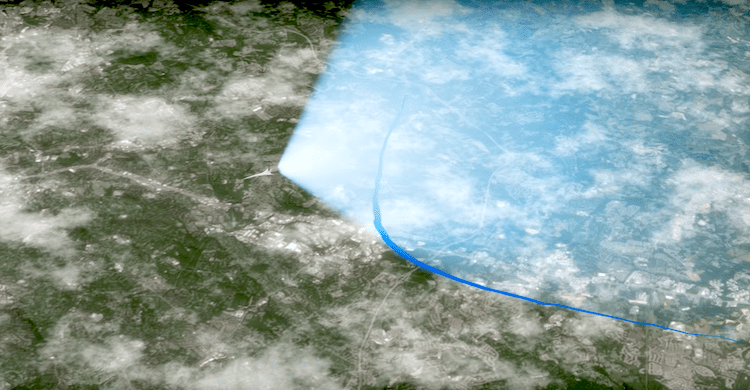
A computer simulation model showing NASA’s concept of operations for its QueSST X-59 low sonic boom flight demonstrator program. Photo: NASA
Collins Aerospace engineers are developing a modified version of Pro Line Fusion, new software applications and an enhanced vision system for NASA’s X-59 Quiet SuperSonic Technology (QueSST) aircraft.
QueSST is being developed as a demonstrator aircraft that NASA will use to help civil aviation regulators develop airworthiness noise standards to certify and regulate future supersonic transport designs. NASA awarded a contract to Lockheed Martin Skunk Works in 2018 to design, build and flight test the X-59 low boom flight demonstrator.
Lockheed has selected Collins to supply a modified version of its Pro Line Fusion integrated avionics suite for the aircraft. Among the X-59 specific software applications being developed by the UTC subsidiary will be the ability of their systems to show pilots where the aircraft’s sonic boom will generate a noise impact on the ground, according to Dave Schreck, vice president and general manager for military avionics and helicopters at Collins Aerospace.
“One of the focus areas is to develop a fairly accurate representation on the ground of where the sonic boom would exist. We’re considering things such as artificial intelligence to aid in pilot decision-making so they can not only see where the boom will be generated but also what decide on what type of actions they can take to optimize their flight profile,” Schreck said.
NASA’s X-59 design replaces the pilot’s traditional front window view with sensor display technology in the form of a windowless display cockpit system. When landing, X-59 pilots will use Collins’ EVS-3600 enhanced vision system to view real-time imagery of runway lighting, terrain and obstacles.

Collins Aerospace combined vision system technology merges enhanced and synthetic vision technology into one display. Photo: Collins Aerospace.
Under their contract, Collins will provide dual enhanced vision systems with the ability to overlay views from short and long wave infrared coupled with visible light – all merged into one picture. Lockheed is using its system integration lab in Palmdale, California to house the development of Pro Line Fusion featuring customizations necessary to support the type of flying the X-59 will demonstrate. Schreck confirmed that Collins engineers started working out of the integration lab in late 2018.
Outside of software application development, another focus area of the development team is to provide as much weight reduction as possible.
“We’re doing everything we can to eliminate some of the non essential components. For example, we’re evaluating how we can minimize the number of control panels in the traditional Pro Line Fusion setup on some of the commercial and business jets in service today,” Schreck said.

X-59 design concept. Photo: Lockheed Martin.
Collins is the latest in a series of avionics and engine supplier contracts around several major supersonic air transport aircraft development programs.
At NBAA 2018 for example, Aerion confirmed GE Aviation and Honeywell Aerospace as the engine and avionics suppliers for its $120 million AS2 supersonic business jet.
Executives from Aerion and Colorado-based Boom Aerospace recently participated on a panel discussion outlining projected market demand and business models around their respective future supersonic civil jet designs. Both Aerion and Boom expect to field the next generation of supersonic aircraft by the mid 2020s.
The results of NASA’s QueSST program will help inform civil aviation regulatory authorities on what is achievable in terms of publicly acceptable sound and speed regulations for supersonic aircraft with quieter designs.
NASA has also made other recent avionics supplier selections for the X-59, including the use of CoreAVI’s Vulkan driver to support the graphics and computing capabilities of the aircraft’s external vision system.
Now, with Collins in place as the primary avionics supplier, NASA and Lockheed are continuing their effort to meet a first flight goal for the X-59 by 2021.